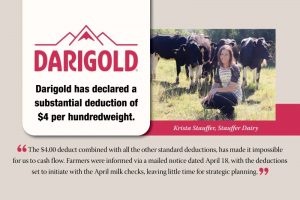
Higher prices generated more production. At the same time, consumers responded to higher prices by consuming less. The old saying “high prices cure high prices” once again rears its head in the milk industry. For nearly a year, prices have been in a steady downtrend. Production numbers have steadily risen due to increased milk cows as well as efficiency per cow. In other words, more production and less demand. Prices are hovering near $18 a hundredweight or less. The question now: Have prices moved low enough to generate renewed demand? Additionally, have prices moved low enough to encourage producers to cut back on production?

There may be three phases to the dairy market when it comes to production.
Phase 1: When prices are high, production generally increases. Producers respond to higher prices with the ability to expand their operations. Cash flow is important. Generally, when extra cash is available, attention towards growth becomes paramount.
Phase 2: Increased production pressures prices and farm income begins to suffer. Dairy producers generally do what they do best at this point, and that is to produce even more. In a simple world, if dollars per cow are down, you would try to maximize even more production out of each cow. Ultimately, the stage is set for oversupply. Typically, this is represented in lower spot and distant futures prices.
Phase 3: Production becomes overburdensome and supplies more than plentiful for the marketplace. This is when prices are pressured to the point where producers now feel enough pain and start acting to either curb production, cut costs, or both. It is also a phase where demand typically responds to lower prices and begins to pick up. However, demand generally doesn’t turn on and off like a light switch; rather, it builds over time.
It is likely the market is currently at the end of Phase 2 or at the beginning of Phase 3. Continuous down-trending prices, along with increasing input prices (such as feed, labor, and materials) tend to pinch the bottom line to the point where reductions begin. Typically, this will be reflected in milk production reports that show declining cows being milked. While those numbers are not yet evident, they are likely to surface in the months ahead. However, with revenue insurance products that have become available over the last five to ten years, we could see prolonged increased production. High beef prices could encourage breeding of cows, with beef animals keeping dairy cows in the cycle longer than anticipated. The latter argument is up for debate, as high beef and live cattle prices may also encourage more aggressive marketing of cows.
From a marketing perspective, the lessons learned over the last year are that high prices tend to cure high prices. If expectations are for production to increase, expect ultimately that prices will not hold up. A long-term vision of defensive marketing after high prices is something that each dairy farmer should consider as they build a long-term strategic approach, reflecting and preparing for what price and production may look like.
Plan your strategy to protect prices and mitigate risk, no matter where the market goes. Be sure to know what you’re getting into before entering any position. Consider visiting with a professional to understand the risks and rewards of your strategy.























